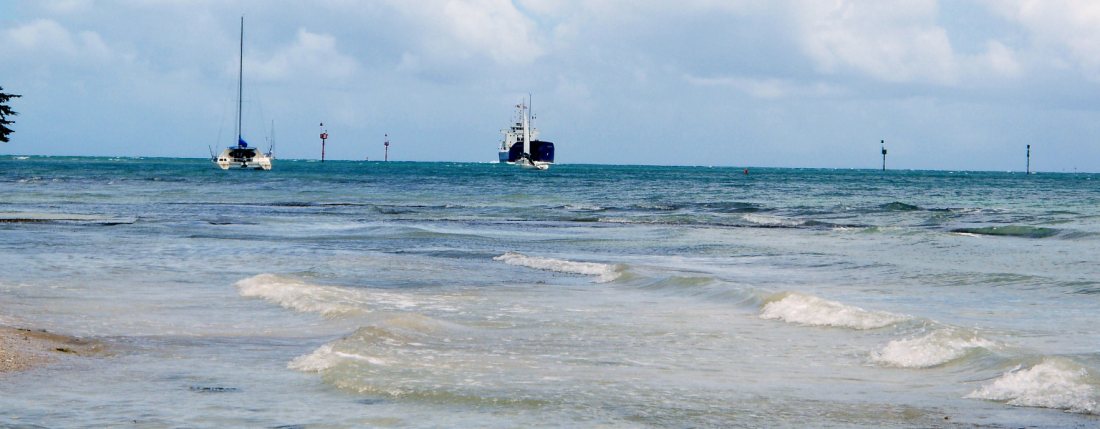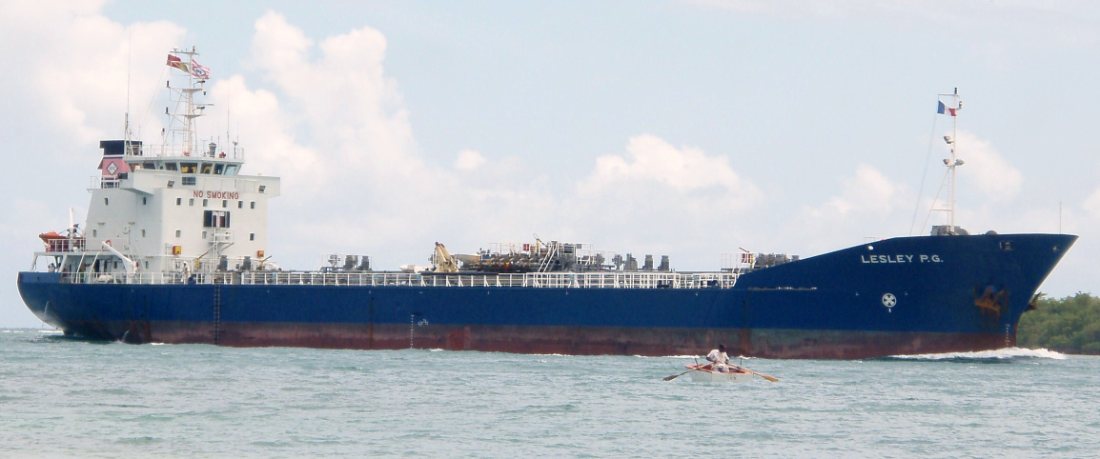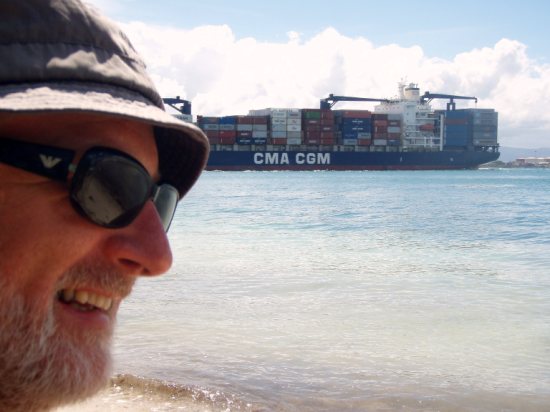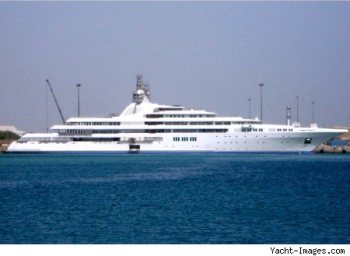|
The Largest Ship in the
World
We try to get to the beach for a swim most days after chores,
even if it's just for an hour. We both love to watch the pilots go racing out to
guide one of the big container ships in, well that got me asking "what's the
biggest", then thinking about a variety of classes and comparisons.

This girl is called Lesley P.G. and
gave five good hoots, (what are your intentions) which got yachts darting out of
her way.

Even funnier was this little chap
rowing for all his might across the bay - no mean feat into a strong wind
- suddenly he saw Lesley over his shoulder and almost died of shock.


A great way to spend an afternoon
The Knock Nevis is a
Norwegian owned supertanker, formerly known as Seawise Giant, Happy Giant, and
Jahre Viking. She is 458 metres (1504 feet) in length and 69 m (226 ft) in
width, making her the largest ship in the world. She was built between 1979 and
1981, damaged during the Iran-Iraq War, and refloated in 1991.
Knock Nevis has
a deadweight of 564,763 tonnes and a summer displacement of 647,955 t when laden
with nearly 650,000 m³ (4.1 million barrels) of petroleum. She sits 24.6 metres
in the water when fully loaded, which makes it impossible for her to navigate
even the English Channel, let alone man-made canals at Suez and
Panama. The supertanker was built at Sumitomo Corporation's
Oppama shipyard in Japan for a Greek owner who refused to take delivery of the
vessel due to extensive vibration issues related to faulty gear design.
Following an unsuccessful arbitration against the yard, the vessel was sold to
Chinese interests. The unfinished ship was bought by a Hong Kong shipping
magnate Tung Chao Yung (shipping line OOCL) who had her extended by several
metres, thus increasing her load-carrying capacity and making her the largest
ship ever built. The ship was finally floated two years later and named Seawise
Giant. This is a pun on the name of the owner, who abbreviates his name as C. Y.
Tung. Tung Chao Yung experienced significant financial difficulties as a result
of the lengthening and was eventually supported through contacts with the
government of the People's Republic of China. At first, she operated between the
Middle East and the USA but from about 1986 she was used as a floating storage
ship and transhipment terminal in Iran during the Iran-Iraq War. In May, 1988,
the ship was attacked and heavily damaged by bombs dropped from Iraqi jets while
lying at the Iranian Hormuz terminal in the Strait of
Hormuz.

At the end of the Iran-Iraq War in late 1989, the wreck (which
had by then been towed to Brunei) was bought by a Norwegian limited liability
partnership ("KS-company") managed by Norman International. They had the wreck
repaired by the Keppel Shipyard in Singapore, and renamed Happy Giant. However
in 1991, before the repairs were completed, the KS-company became managed by
Norwegian shipping company Jørgen Jahre, and the vessel was delivered from
Keppel Shipyard as the Jahre Viking. During the late 1990s, the majority of the
KS-company was bought by Norwegian shipowner Fred Olsen through his company
First Olsen Tankers. In March 2004, the ship was sent by her new owner, Fred
Olsen Production (FOP), a wholly owned subsidiary of First Olsen Tankers, to the
shipyard Dubai Drydocks to be refitted as a floating storage and offloading unit
(FSO). There, she was given her current name, Knock Nevis. The ship is now
permanently moored in the Qatar Al Shaheen oil field in the Persian Gulf,
operating as a FSO.
 
Name:
Knock Nevis
IMO
No: 7381154
Ex:
Jahre Viking-2004; Happy Giant-1991 Seawise
Giant-1989
Built:
12/1976
Type:
Tanker
Status:
In service as
FSO.
Subtype: Crude
Flag: Norway
(NIS)
DWT:
564,761 ( After reconstructing
)
Draft: 24.61
Builder: Sumitomo H.I.
(1016)
GT:
236,710
LOA: 458.45
Owner: First
Olsen Tankers Pte. Ltd.
NT:
214,793
Beam:
68.86
Speed/Cons: 13.00/-
Class: NV
Depth:
29.80
Engine Type: Sumitomo Stal-Laval AP steam turbines,
50.000 PS, 37300 kW by 85 RPM
Cubic:
658,362


Sovereign Maersk
breaks Port of London Record on the
14th of August 2007. The largest -
ever container ship to navigate the Thames has arrived in the Port of London.
The 'Sovereign Maersk' (6,600 teu) was at Tilbury Container
Services for just one day before sailing to Rotterdam, but it smashed all
records for the river. At a whopping 346 metres, it is longer than three Wembley
football pitches laid end to end, and 47 metres longer than the Port's previous
record holder 'Maersk Kalmar'. Traditionally the biggest regular visitors to the
Thames have been the 272 metre 'Monte Class' Hamburg Sud vessels that run
between London and the South American east coast. Richard Everitt, the Port of
London Authority's chief executive, said: "Working together, the PLA, Tilbury
Container Services and Maersk have confounded the traditional assumptions of
what is possible on the Thames. "Not long ago the Sovereign Maersk was the
world's largest container ship. Its successful visit has demonstrated that
London is a progressive alternative port for UK calls."
Her Majesty the Queen of Denmark, accompanied by HRH Prince
Henrik, honoured in September 1997 Odense Steel Shipyard and A.P. Moller by
naming the world’s largest container vessel at the time. Royal naming before
Sovereign Maersk, Her Majesty the Queen had three times honoured A.P. Moller by
being sponsor of a vessel. The heir apparent named the tanker A.P. Moller – the
first vessel delivered to A.P. Moller after the death of its founder – in 1966.
During a state visit to Japan in 1981 Her Majesty the Queen honoured A.P. Moller
by naming the product tanker Peter Maersk, named after A.P. Moller’s father,
Captain Peter Maersk Moller. In 1991 Her Majesty named the container vessel
Majestic Maersk – obviously named. Sovereign Maersk, speed 25 knots - was
constructed in only 201 days and has a cargo carrying capacity of 6,600 TEU –
600 more than the six vessels in the existing series of so-called post-panamax
vessels whose size does not allow them to sail through the Panama Canal.
Sovereign Maersk’s length is 346 metres, and the vessel is 42 metres wide – the
dimensions of the Panama Canal allows a maximum length of 294 metres and a width
of 32 metres.


The France II was a French sailing ship
and the second one of that name. She was the largest sailing ship in the world
merchant fleet ever built. She was an extremely large tall ship of 5,633 GRT and
of square rigging as s five-masted steel-hulled barque. Her five masts, all
yards and the spanker boom were made of steel tubing, lower mast and topmast
made in one piece. She featured a so-called "jubilee rig", also called
"bald-headed rig", i. e. she was rigged with no royal sails above double top
sails and double topgallant sails. She had a huge sail area of 6,350 m² [68,350
sq ft]. Her long yards and the less tall masts gave her a rather wide and
depressed appearance in comparison to other tall ships of her class. She was
146.5 meters (480.5 ft) long, her displacement was 10,710 t (10,541 tons (tons
standard (ts)), and she could carry 7,300 tons of cargo. The vessel had some
wooden components built in, including wooden deck covering, a beautiful lounge
equipped with a piano and precious furniture, seven luxury passenger cabins, a
library, a darkroom, and a seawater therapy equipment making her one of the most
elegant sailing cargo carriers. Her deck-line was striking in that she had an
extremely long poop similar to sail training ship, forecastle, and midship
island (three-island-ship) with only two short open upper deck sections, each
containing one of her huge loading hatches.
History: Built in 1911 at the Gironde yards ("Chantiers et
Ateliers de la Gironde") in Bordeaux according to the plans of chief
designer Gustave Leverne (1861-1940) for the nickel ore trade and was owned by the
"Société Anonyme des Navires Mixtes (Prentout-Leblond, Leroux & Cie.)". The
huge barque was equipped with two Schneider 950 hp diesel engines which have
been removed in 1919. At that time she became the largest sailing ship ever
built. Her crew consisted of 5 officers: captain, 2nd captain (on French
ships); a naval officer of a captain's rank as a
vice-captain and security officer), 1st, 2nd, and 3rd
mates and 40 able seamen including cook, steward, sailmaker ship's carpenter,
later on (1919) the brew numbered 45. In 1915 she was sold to Leroux-Henzey, in
1916 to the "Compagnie Française de Marine et de Commerce" ("French Company of
Marine and Trade"), all of Rouen, her port of registry remained the same.
During the night of the 12th of July 1922 she went aground on the Teremba
reef (Urai bay) north west to the Ouano reef, nearly 60 nm north west of Noumea,
New Caledonia, homeward bound to Europe with a cargo of
chrome ore from Pouembout. Because of fallen cargo rates her owner refused to
tow her free from the Ouano reef by a tug which was absolutely possible. In
1944, American bombers bombed the wreckage as a targeting practice. There are
currently plans to build a replica of the France II.

The World's Biggest Submarine is
Russian. The
Typhoon.
Displacement: 33,800 tons
submerged
Dimensions: 172 x 23.3 x
11 meters/564.3 x 76.4 x 36 feet
Propulsion:
Steam turbines, 2 OK-650 reactors, 2 shafts,
100,000 shp, 25
knots
Crew:
160
Sonar:
Skat series/Shark Gill LF active/passive
suite
Armament: 20
RSM-52/SS-N-20 Sturgeon SLBM, 6 21 inch torpedo tubes (20+ Type 53-65K, SET-65,
SAET-60M torpedoes and/or RPK-6/SS-N-16 Vodopod/Stallion ASROC), 1 SA-14 SAM
position
The Ohio Class submarine is the largest US
Submarine
Displacement: 18,750
tons
submerged
Dimensions:
560 x 42 x 36.25 feet/170.7 x 12.8 x 11
meters
Propulsion:
1 S8G reactor, steam turbines, 1 shaft, 35,000 hp, 25
knots
Crew:
Dual crews; 163 each
crew
Sonar:
BQQ-6 or BQQ-5E(V)4 passive suite (bow array), TB-23 towed array
Fire Control: CCS Mk 2
combat system, Mk 98 missile control, Mk 118 torpedo
control
EW: WLR-8(V)5
suite, 8 countermeasures launchers (SSBN 738-743: 15
launchers)
Armament:
24 Trident II D-5 SLBM (Trident I C-4 in SSBN 727-731, 733), 4 21 inch torpedo
tubes (Mk 48 torpedoes)

The Russian Ladies
Queen Mary 2
-
Gross Tonnage: 150,000 tons (approx.)
-
Length: 1132
feet (345 metres)
-
Beam: 135
feet (41 metres)
-
Beam at Bridge: 147 feet 6 inches (45 metres)
-
Draft: 32
feet 8 inches (10 metres)
-
Height : 236
feet 2 inches (72 metres)
-
Passengers:
2,620 (3,090 max)
-
Decks:
19 (17 pax)
-
7th Jun 1998: 'Project Queen
Mary' announced and initial plans for a new liner unveiled.
-
8th Nov 1999: General plans
completed and first images released.
-
10th Mar 2000: Letter of intent
signed with Chantiers de L'Atlantique in France.
-
6th Nov 2000: Formal
contract signed.
-
16th Jan 2002: First sheet of
steel cut.
-
4th Jul 2002:
Keel laying ceremony Captain Ron Warwick appointed Master Designate.
-
1st Dec 2002: Float
out.
-
25th Sep 2003: First sea trials.
-
7th Nov 2003: Second sea
trials. Speeds of 30knots reached.
-
22nd Dec 2003: Formal hand-over of
QM2 to Cunard Line.
-
26th Dec 2003: Maiden arrival in
home port of Southampton, England.
-
8th Jan 2004: Queen Mary 2
named by HM Queen Elizabeth II
-
12th Jan 2004: Departure on Maiden
Voyage from Southampton to Fort Lauderdale, USA.
-
16th Apr 2004: Maiden
Transatlantic Westbound crossing to New York.
-
25th Apr 2004: Historic Eastbound
Transatlantic crossing in tandem with QE2.
The RMS Queen Mary 2 is a Cunard
Line ocean liner named after the earlier Cunard liner Queen
Mary, which was in turn named after Mary of Teck, the Queen Consort of George V. It does not commemorate the reign of Queen Mary
II. At the time of her construction in 2003 by the Chantiers de
l'Atlantique, the Queen Mary 2 was the longest, widest and tallest passenger ship
ever built, and at 148,528 gross register tons (GRT), was also the largest. She lost the gross
tonnage distinction to Royal Caribbean International's 154,407 GRT Freedom of the Seas
in April 2006,
but Queen Mary 2 remains the largest ocean
liner (as
opposed to cruise ship) ever built, and her width, length, and waterline breadth are
unsurpassed by any other passenger ship. Moreover, the Queen Mary 2
displaces approximately 76,000 tons; the Royal Caribbean Freedom ships
displace about 64,000 tons. The Queen Mary 2 was the first major ocean
liner built since the Queen Elizabeth 2 in 1969. Queen Mary 2's facilities include 15
restaurants and bars, five swimming pools, a casino, a ballroom, a theatre, and a planetarium. Cost £460 million.

 
Top the Queen Mary 2 ready to leave Sydney.
Meeting the QE2 at Lady Liberty and her side
view.
The RMS Titanic was an Olympic-class
passenger liner owned by the White Star Line and built at the Harland and
Wolff shipyard in Belfast. For her time, she was the largest passenger
steamship in the world.
On the night of the 14th of April 1912, during her maiden
voyage , Titanic hit an iceberg and sank two hours and forty minutes
later, early on the 15th of April 1912. The sinking resulted in the deaths
of 1,517 people, making it one of the most deadly peacetime maritime
disasters in history. The high casualty rate was due in part to the fact that,
although complying with the regulations of the time, the ship did not carry
enough lifeboats for everyone aboard. The ship had a total lifeboat capacity of
1,178 people even though her maximum capacity was 3,547 people. A
disproportionate number of men died also, due to the
woman-and-children-first protocol that was followed. The Titanic used some of
the most advanced technology available at the time and was, after the sinking,
popularly believed to have been described as
“unsinkable”. It
was a great shock to many that, despite the extensive safety features and
experienced crew, the Titanic sank. The frenzy on the part of the
media about Titanic's famous victims, the legends about the sinking, the resulting changes to maritime
law, and the discovery of the wreck have contributed to the interest in and fame of the Titanic that
continues to this day.

Diesel Engine The
Wartsila-Sulzer RTA96-C turbocharged two-stroke diesel engine is the most
powerful and most efficient prime-mover in the world today. The Aioi Works of
Japan's Diesel United, Ltd built the first engines and is where some of these
pictures were taken. It is available in 6 through 14 cylinder versions, all are
inline engines. These engines were designed primarily for very large container
ships. Ship owners like a single engine/single propeller design and the new
generation of larger container ships needed a bigger engine to propel them. The
cylinder bore is just under 38" and the stroke is just over 98". Each cylinder
displaces 111,143 cubic inches (1820 litres) and produces 7780 horsepower. Total
displacement comes out to 1,556,002 cubic inches (25,480 litres) for the
fourteen cylinder version.
Some facts on the 14 cylinder version:
-
Total engine weight: 2300 tons (The
crankshaft alone weighs 300 tons)
-
Length: 89
feet
-
Height: 44
feet
-
Maximum
Power: 108,920 at 102 rpm
-
Maximum
Torque: 5,608,312 lb/ft at 102
rpm
Fuel consumption at maximum power is 0.278 lbs per hp per hour (Brake
Specific Fuel Consumption). Fuel consumption at maximum economy is 0.260
lbs/hp/hour. At maximum economy the engine exceeds 50% thermal efficiency. That
is, more than 50% of the energy in the fuel in converted to motion. For
comparison, most automotive and small aircraft engines have BSFC figures in the
0.40-0.60 lbs/hp/hr range and 25-30% thermal efficiency range. Even at its most
efficient power setting, the big 14 consumes 1,660 gallons of heavy fuel oil per
hour.

USS Harry S.
Truman (CVN-75) is the eighth Nimitz-class
supercarrier of
the United States Navy, named after the 33rd President of the
United States.
Construction: The keel was laid by Newport News
Shipbuilding on the 29th of November 1993 and the ship was christened on
the 7th of September 1996. HST was authorized and laid down as USS United
States but her name was changed after the keel laying. Three Newport News
shipworkers died during construction when a pump room filled with methane and
hydrogen sulphide gases during a sewage leak on Saturday, 12 July 1997. They are
commemorated by a brass plaque in the tunnel off Hangar Bay number 1. The
official launching of the ship was on 13 September 1996. The crew moved aboard
ship from contract housing in Newport News in January 1998. The ship
successfully completed builder's trials on the 11th of June 1998 and acceptance
sea trials on
the 25th of June 1998 before being commissioned on the 25th of
July 1998. The builder's trials and sea trials were delayed from the initial scheduling
dates in May 1998 due to noise issues in one of the reactor closure heads during
hydrostatic testing. Two brass plaques in the entrances to the Reactor Rooms
list all personnel on watch in the Reactor Room and Main Machinery Room (MMR)
when number 1 and number 2 reactors first became "critical". One of the crew
members is incorrectly listed as MM2 Pres Ilog, when that member was an MM3 for
more than two years after that date.
USS Enterprise (CVN-65) , formerly
CVA(N)-65, is the world's first nuclear-powered aircraft
carrier and the
eighth U.S. naval vessel to bear the name. Like her predecessor of WWII fame, she is nicknamed the "Big E." At
1,123 ft (342 m), she is the longest naval vessel in the world, though her 93,500 tons
displacement places her as the second heaviest
supercarrier,
surpassed only by the Nimitz-class. Enterprise is a single class
ship and is
currently the oldest active vessel still in commission under the US
Navy, excluding
the ceremonial commission of USS Constitution. As the oldest carrier in the fleet, she
is currently scheduled for decommissioning some time in 2014-2015 depending on the
life of her current reactors and when the construction of her replacement, the
USS Gerald R. Ford, is completed. Efforts for an earlier retirement in 2012-2013 is
under consideration but has to be approved by Congress. At earliest possible
date, Enterprise would retire with just over 50 years of continuous service,
serving as the longest of any aircraft carrier in the history of the United
States Navy. Enterprise is currently homeported at Norfolk,
Virginia.
 
Harry S. Truman and Enterprise (second
photo)
Double-decker buses are in
common use throughout the UK and have
traditionally been favoured over articulated-buses by many operators, though
this primarily down to the shorter length of double-deckers and less need to
have standing capacity. The majority of double decker buses in the UK are
between 9.5 and 11.0 metres long, the latter being more common since the
mid-1990s though there are 3-axle 12.0 metre models in service with some
operators. Double-decker coaches in the UK have traditionally been 12.0 metres
in length, though many newer models are about 13.75 metres. The maximum
permissible length of a rigid double-decker bus and coach in the UK is 15.0
metres, and although there are no theoretical restrictions on height, coaches
are normally built to 4.0 metres high while 'highbridge' buses are normally
about 20 centimetres taller. Articulated double-deckers are also allowed at a
maximum length of 18.75 metres. Double-deckers have become a symbolic image of
the country in particular the use of the red double decker buses in
London. A particularly iconic example was the
Routemaster bus, which had been a staple of the public
transport network in London for nearly half a century
following its introduction in 1956. Because of cited difficulties accommodating
disabled passengers, the last remaining examples in use finally retired in 2005,
although Transport for London has established two
"heritage routes", which will continue using Routemasters.
  
Abramovich to Complete World's Largest Yacht. Posted on the
13th of April 2009
It seems that despite a disastrous economy in which he lost a
reported $20 billion, Russian oligarch Roman Abramovich is pressing on with
plans for the Eclipse, the $355 million megayacht which will be the world's
biggest upon completion next year. The 555-ft. ship, which includes a
military-grade missile defense system, armour plating and bullet-proof windows,
will literally eclipse the recently-debuted $350 million, 531-ft. Dubai owned by
Sheikh Mohammed bin Rashid Al-Maktoum, the Emir of Dubai. There has been much
speculation over whether Abramovich would shelve the Eclipse and / or sell off
some of his other superyachts such as the 377-ft. Pelorus, but the Moscow
Times reports he plans to keep them all. In fact, Abramovich is said to
have already purchased a berth for the Eclipse at Porto
Montenegro, the new megayacht marina under construction in the former communist
country being billed as "the Monaco of the Balkans" .
World's Largest Yacht: Sheikh Mohammed bin
Rashid Al-Maktoum,
the Emir of Dubai, has finally
unveiled the largest yacht in the world. Formerly known as Project Panhandle /
Golden Star, the 531-ft. Dubai (was originally commissioned by Prince Jefri of
Brunei. Al-Maktoum purchased the
partly-constructed behemoth in 2006, and had it transported from Blohm &
Voss in Hamburg to the the newly formed Platinum Yachts shipyard in Dubai for
completion (renamed then Project Platinum), at a total cost of about $350
million. With eight decks, the Dubai can accommodate 115 people including a crew
of 88. In addition to the swimming pool, Jacuzzis, helipad and multiple dining
areas, saloons, guest and VIP suites, the yacht features two owner's suites on
the sixth and seventh decks and two heli-observations rooms on the seventh and
eighth decks, Superyacht Times reports.
The interior is garish in the extreme, a floating Las Vegas casino by way of the
UAE. She has a maximum speed of 26
knots and a cruising speed of 25 knots with a range of 8,500 nautical miles. The
Dubai may not hold its world's largest yacht title for long, however; as we
reported back in October, Russian oligarch Roman Abramovich commissioned an even
larger yacht,
the $355 million, 555-ft.


Eclipse and Dubai
Athena is a clipper-bowed 3-masted gaff rigged
schooner built by Royal Huisman Shipyard in 2004 for
internet entrepreneur James H. Clark. Clark purchased a 47.4 meter
sloop, Hyperion, from Royal Huisman in 1998. As Hyperion was nearing
completion, Clark began to consider the possibilities of a larger yacht, which
could include a theater, library, more guest space and a more capable galley.
Athena can normally be chartered for $500,000 per
week but whilst she was moored in Cairns in October 2007 a sign had been
placed giving information about the yacht and stating that contrary to
information on the internet the yacht is not available for charter. Athena is
the winner of the Show Boats International Award for Best Sailing Yacht over 40
Metres for 2004. Similar sailing super yachts include
Eos and The Maltese Falcon.
The Maltese Falcon is a
clipper sailing luxury yacht owned by American
venture capitalist Tom Perkins. It is one of the largest privately-owned
sailing yachts in the world at 88 metres (290 feet).
She was built after the Dynaship or
Dyna-Rigg concept, a 1960 invention of the German engineer
Wilhelm Prolss which was intended to operate commercial freight
sailing ships with as few crew as possible. The ship has fifteen square sails
(five per mast), stored inside the mast; they can fully unfurl into tracks along
the yards in six minutes. The three carbon fibre masts, which are
free-standing and able to rotate, were manufactured and assembled by a company
financed by Perkins at the Perini Navi Istanbul "Yildiz Gemi" (literally: Star Ship) yard in
Tuzla, 50 miles east of Istanbul, under the supervision of the
English company Insensys and Dutch company Gerard Dijkstra & Partners. Other
design was provided by Ken Freivokh Design. The Falcon was the third
yacht built by Perini for Perkins. The yacht is easily controlled and has been
seen to sail off her anchor and away from berths within harbors. The yacht's
sophisticated computer detects parameters such as wind speed automatically and
displays key data. An operator must always activate the controls, yet it is
possible for a single person to pilot the yacht. In a radio interview for the
BBC World Service's Global Business programme broadcast in December 2007,
Perkins revealed that he personally wrote some of the yacht's unique control
software. The Falcon has two 1,800 horse-power
Deutz engines running at 1,800
rpm with a top speed of 20 kn (23
mph; 37 km/h) with minimal wave-making and virtually no vibration or noise and
with a smooth and non-turbulent wake. The yacht has a permanent crew of 18 to
maintain the technical aspects including the rig and to operate the onboard
"hotel", which can accommodate twelve guests plus four guest staff. The boat
also includes an onboard gourmet chef, stewards and stewardesses. The
Falcon was registered in Valletta, Malta in 2006. She completed her trial sail in the
Sea of Marmura to the
Bosphorus strait on the 12th of June
2006, and made her maiden voyage from Turkey to Italy via
Malta in July 2006. Since that time, Perkins has
been renting out The Falcon for between € 325,000 to 335,000 per week
plus expenses. Lusso Magazine ran a cover feature
on The Maltese Falcon in their January 2008 edition, where they reported that
yacht brokers Edmiston and Company were the first to set up a charter – for "a
piffling €350,000 per week. This price includes a crew of 16, but you still have
to pay for food and wine". In a 60 Minutes profile on the 4th of November 2007, Perkins
suggested the yacht cost more than $150 million but less than $300 million, but
refused to be more specific.
Eos is a three masted Bermuda rigged schooner
sailing luxury yacht, currently owned by Barry
Diller. It is one of the largest private sailing yachts in the world,
its overall length measuring approximately 305 feet (93 m). She was launched in
Germany from the Lurssen yard in 2006 after being designed by Bill
Langan, with Rondal/Huisman supplying the rig, and the naval architecture being
completed by the Lurssen team. The interior was designed by François
Catroux. The yacht has been docked in Venice since July 2008. The Eos has been
spotted at Raffles Marina, Singapore, as of the 18th of April 2009.
Characteristics
- Length Overall: (LOA) - 304.86 feet (a
significant amount of Eos' overall length comes from her
bowsprit
)
Length on Deck: (LOD): 271 feet (83
m)
Waterline Length: (LWL): 233 feet
(71 m)
Beam: 44.29 feet (13.50
m)
Hull
Material:
Aluminium
Gross
Tonnage: 1500
Engines:
2 x 2,333 hp (1,740 kW) MTU Diesels
Propulsion:
Twin Screw
Max
Speed: 16
knots (30 km/h)
Eos in Dartmouth, The Maltese
Falcon
ALL IN ALL we a VERY happy to stick with
Beez Neez. Length 12 metres, Beam 3.96 metres, Draft 1.7
metres, Weight 14 tonnes, Engine Volvo 50 hp,
we can get into ANY marina, have no staff and a crew of
two. Our
Girl.
|




























